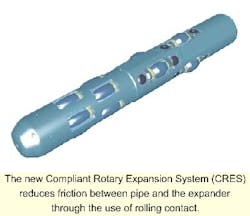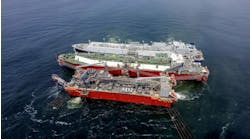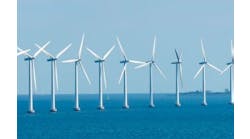DRILLING TECHNOLOGY: Rotating casing expansion one step closer to monobore completions
A competitor to Shell's groundbreaking technology in expandable casing may be developing. Weatherford is in the process of leveraging its knowledge in designing and installing expandable screens into the expandable solids area.
If successful, such a competition may bring the drilling industry one step closer to the ultimate goal of monobore well construction, the ideal for Shell and Weatherford. Monobore wells have a single casing size from some level below the surface casing to the production zones.
Weatherford hit upon an alternative solution for expandable solids while developing its slotted tubular system. Paul Metcalfe, Director of Sand Control and Expandable Technology for Weatherford, said the company was looking for a way to expand these slotted screens so that they would offer better support for the open borehole. The original system pushes an expansion cone with a fixed outside diameter down through the slotted tubular, expanding it to a uniform size. Matching the uneven diameter of the open hole requires a compliant expansion system that can vary the expanded diameter of the screen, Metcalfe said.
The company became involved with Astec, a company that developed a downhole tractor running on coiled tubing. The tractor gripped the walls of the liner with a series of rollers set at an angle that, when rotated by a mud motor, drove the tractor through the liner. The tractor featured a nozzle on its tip to provide back-pressure, activating the rollers that made contact with the liner providing a radial force component.
In the original tool, it was important that the back-pressure be kept low to prevent the rollers on the tractor from deforming the liner. By modifying the tool and increasing the back pressure, Metcalfe said, it was possible to drive this rotating system downhole, deforming the screens as it traveled. The radial travel of the rollers was increased, allowing the tool to expand the slotted liner to fit the varying inside diameter of the open hole.
Transition
Metcalfe said more than 35,000 ft of expandable sand screens have been installed to date, and the next step for the company was to apply this technology to solids. While the initial technology Weatherford used for its slotted expandables was based on the Shell design, Metcalfe said, the solid tubular development is independent of that arrangement.
There are a number of advantages to expanding solids using a rotating axial force, rather than driving a fixed cone from the bottom up, according to Metcalfe. The process is controllable, allowing expansion to be initiated when and wherever required. If necessary, the expansion tool can be recovered in a mid-expansion position, and redeployed to continue the operation.
A major bonus is the ability to clad the casing inside the borehole. The compliant expansion tool conforms to anomalies in the casing as well, so that there is complete contact between the expanding string and the casing already installed.
Because the rotary expansion tool moves downhole on a series of rollers, it experiences low friction, requiring lower internal pressures while exerting high contact force. Weatherford engineers say they are confident the tool can be used to expand a variety of API metals, currently available in tubular form. Depending on the percentage of expansion, the elongation properties, yield, and plastic deformation characteristics required, a variety of products could be used. "Our testing has shown there are plenty of metals out there that fit the bill," Metcalfe said.
Common goals
While the Weatherford approach to deforming solids differs from Shell's approach, many challenges remain. Chief among these is the expandable connection. Enventure's (a commercial developer of Shell's process) system reportedly uses a proprietary left-hand threaded connection in its installations. Metcalfe said Weatherford is still considering designs working with major connection vendors and also in-house. Because the rotary expansion cone travels downhole in a clockwise rotation, it will actually work in favor of conventional right-hand connections. Enventure's system deforms the tubulars from the bottom up, so that the left-hand thread works best.
The challenge of making a good connection between two casing strings is a key hurdle Weatherford faces on its way to developing a monobore well concept. Metcalfe said the internal and external casing at these junctions may have to expand together, one inside the other to make a reliable seal. The rotary expansion technique is capable of achieving this.
Beyond questions of expansion are those of cementing expanded tubulars. By virtue of their design, these strings provide a narrower annulus for cementing. Current expansion technology cements the string before the expansion occurs. Metcalfe said that just because the Weatherford technology can conform to the borehole does not mean it can be run without a cement job.
Unsupported casing is always a risk. To overcome this would require an annulus to remain around the expanded string to allow for cementing. The design of the rotary expansion sub features a set of conforming rollers as well as a set of fixed rollers. The rollers provide the driller the option of either expanding to conform with the borehole so it could, for example, clad to an existing casing string or expand to a fixed outside diameter that leaves space for a cementing job.
Application
The key areas for application of this emerging technology, according to Metcalfe, will be in well construction, which is no surprise. Expandables present operators with a variety of well design options that allow them to achieve a deeper total depth with a larger production annulus.
Other advantages are in the area of contingency casing strings. Expandable liners allow the operator to isolate a troubled zone without sacrificing a casing string. With deepwater and ultra-deepwater targets being identified further below the mudline, such technology is welcome. In fact, Enventure, which is licensed with Shell's technology in the US, has had a number of successful field applications in the Gulf of Mexico.
While Enventure is already in the field with its expandable solids technology, Weatherford is still at least six months away from commercializing a liner system, and Metcalfe readily admits that six months is an optimistic, fast-track estimate. Still, with the Enventure system gaining acceptance with every successful job it runs, the opportunity for an alternative product line can only expand industry acceptance of this new technology.




